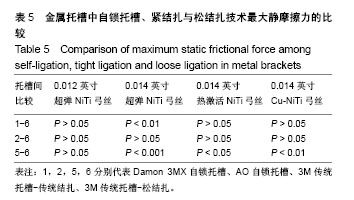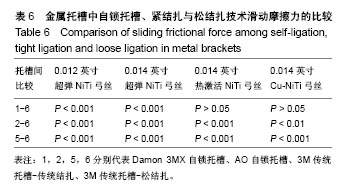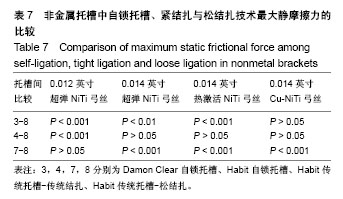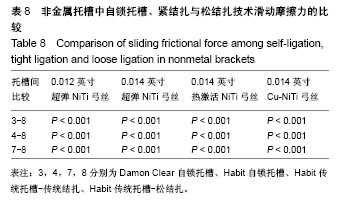| [1] 郭杰.临床结扎力量与口内托槽沿不锈钢弓丝滑动的摩擦力[J].国外医学:口腔医学分册,2004,31(4):328.[2] 林新平.临床口腔正畸生物力学机制解析[M].北京:人民卫生出版社,2012:106.[3] Shivapuja PK,Berger J.A comparative study of conventional ligation and self-ligationbracket systems.Am J Orthod Dentofacial Orthop.1994;106(5):472-480.[4] Kusy RP,Whitley JQ.Friction between different wire-bracketconfigurations and materials//Seminars in orthodontics.WB Saunders,1997;3(3):166-177.[5] 张明灿,李洪发,武杰等.松结扎在正畸排齐阶段的初步研究[J].中国美容医学,2014,23(8):655-658.[6] 张明灿,赵丽丽,孙海媛,等.不锈钢结扎丝松结扎法在口腔正畸固定矫治术中的应用体会[J].山东医药,2015,55(26):106-107.[7] 段沛沛,张林,赵青,等.自锁托槽矫治系统相关生物力学的研究进展[J].国际口腔医学杂志,2012,39(5): 661-663.[8] 刘刚,杨丽,刘斌,等.口腔正畸摩擦研究进展[J].摩擦学学报, 2018, 38(2):238-246.[9] Papageorgiou SN,Konstantinidis I,Papadopoulou K,et al.A systematic review and meta—analysis of experimental clinical evidence on initial aligning archwires and archwire sequences.Orthod Craniofac Res.2014;17(4):197-215.[10] 林新平.临床口腔正畸生物力学机制解析[M].北京:人民卫生出版社,2012:102.[11] 张昊,王林,马俊青.口腔正畸弓丝表面改性技术的研究进展[J].口腔生物医学,2013,4(4):209-213.[12] 蔡先彬.复合工艺聚四氟乙烯涂层的摩擦学研究[D].苏州大学, 2016.[13] 邵玶,隋解和,冯雪,等.TiNi 合金牙弓丝表面环氧树脂/聚四氟乙烯涂层的组织结构与性能[J].稀有金属材料与工程, 2012,41(5): 822-825.[14] Farronato G,Maijer R,Carìa MP,et al.The effect of Teflon coating on the resistance to sliding of orthodontic archwires. Eur J Orthod.2011;34(4):410-417.[15] 白雪芹,曾祥龙.低摩擦结扎圈在牙齿排齐阶段静摩擦力的实验研究[J].口腔正畸学,2008,15(2):78-80.[16] Henao SP,Kusy RP.Evaluation of the frictional resistance of conventional and self-ligating bracket designs using standardized archwires and dental typodonts.Angle Orthod. 2004;74(2): 202-211.[17] 张丽雯,宋立滨,张瑾,等.不同托槽与弓丝组合滑动摩擦力的实验研究[J].中华口腔正畸学杂志,2017,24(1):10-13.[18] Thorstenson GA,Kusy RP.Comparison of resistance to sliding between different self-ligating brackets with second-order angulation in the dry and saliva states.Am J Orthod Dentofacial Orthop. 2002;121(5):472-482.[19] 杨慧芳,赵建江,王勇.3D打印技术在口腔医学领域中的应用[J].中国医疗设备,2015,30(5):63-65.[20] Kasparova M,Grafova L,Dvorak P,et al.Possibility of reconstruction of dental plaster cast from 3D digital study models. Biomed Eng Online.2013;12(1):49.[21] Tavares A,Braga E,Araújo TM,et al.Digital models: How can dental arch form be verified chairside?Dental Press J Orthod. 2017;22(6):68-73.[22] Darroudi AM,Kuijpersjagtman AM,Ongkosuwito EM,et al.Accuracy of a computed tomography scanning procedure to manufacture digital models.Am J Orthod Dentofacial Orthop.2017;151(5):995-1003.[23] Majstorovic N,Zivkovic S,Glisic B.The advanced model definition and analysis of orthodontic parameters on 3D digital models.Srp Arh Celok Lek.2017;145(11-12):11.[24] 冯全胜,马笮,徐文秀,等.口腔3D打印模型与传统石膏模型精确性对比研究[J].中国老年保健医学,2015,13(3):80-81.[25] Alcan T,Ceylano?lu C,Baysal B.The relationship between digital model accuracy and time-dependent deformation of alginate impressions.Angle Orthod.2009;79(1):30-36.[26] Torassian G,Kau CH,English JD,et al.Digital models vs plaster models using alginate and alginate substitute materials.Angle Orthodontist.2010;80(4):474-481.[27] 李晶,王硕,张达,等.口内扫描数字化模型与硅橡胶制取石膏模型测量的对比研究[J].中华口腔正畸学杂志, 2013,20(3):163-166.[28] Hwang CJ,Shin JS,Cha JY.Metal release from simulated fixed orthodontic appliances.Am J Orthod Dentofacial Orthop.2001; 120(4):383-391.[29] 王天丛,陈文静,王文梅,等.单晶和多晶陶瓷托槽与金属弓丝摩擦力的对比研究[J].口腔医学,2013,33(12):821-823.[30] Thomas S,Sherriff M,Birnie D.A comparative in vitro study of the frictional characteristics of two types of self-ligating brackets and two types of pre-adjusted edgewise brackets tied with elastomeric ligatures.Eur J Orthod. 998;20(5): 589-596.[31] Kapur R,Sinha PK,Nanda RS.Frictional resistance of the Damon SL bracket.J Clin Orthod. 1998;32(8):485.[32] Pizzoni L,Ravnholt G,Melsen B.Frictional forces related to self-ligating brackets.Eur J Orthod.1998;20(3):283-291.[33] Peososki RR,Bagby MD,Erick LC.Static frictional force and surface roughnessof nickel-titanium arch wires.Am J Orthod. 1991;100(4):341-348.[34] 王娅婷,王军.自锁托槽与传统托槽的临床比较[J].国际口腔医学杂志,2010,37(4):492-495.[35] 顾月光,赵春洋,马俊青,等.主动、被动自锁托槽摩擦力的meta分析研究[J].口腔医学,2012,32(5):257-262.[36] Offenbacher S,Beck JD,Moss K,et al.Results from the Periodontitis and Vascular Events (PAVE) Study: a pilot multicentered, randomized, controlled trial to study effects of periodontal therapy in a secondary prevention model of cardiovascular disease.J Periodontol.2009;80(2):190-201.[37] Queiroz GV,Ballester RY,De Paiva JB,et al.Comparative study of frictional forces generated by NiTi archwire deformation in different orthodontic brackets: In vitro evaluation.Dental Press J Orthod.2012;17(4):45-50. |
.jpg)










.jpg)
.jpg)
.jpg)